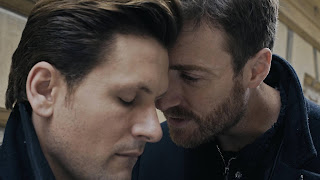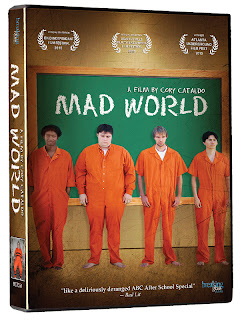Movie Review - Bridge of Spies
Tom Hanks cements his evolution into this generation's Jimmy Stewart. Partnered with director Steven Spielberg who is a filmmaker doing a throwback to the so-called Golden Age when Stewart was in his prime. Yes, this is Spielberg as Frank Capra, George Cukor, Otto Preminger and Alfred Hitchcock all rolled into one. This film is as much Mr. Smith Goes to Washington as it is The Man Who Knew Too Much, and Hanks is very much Stewart in both those roles. Ironically, his character's name also has the first name of Stewart.
Hanks stars as James Donovan, an insurance lawyer living in Brooklyn. He's approached by the federal government to represent a Russian spy who was caught in the same borough in 1957. It may seem odd for this to be put upon an insurance lawyer, but it's clear that James or Jim has had a great career before this, including assisting at the Nuremberg trials.
Amy Ryan (Gone Baby Gone and Birdman) co-stars as Mary McKenna, the wife of Jim. She has three children with him. She's loving and supportive, but she reminds Jim of the cost of taking on this case. She reminds him that representing a Soviet spy in the height of the Cold War will make Jim and his family targets.
Mark Rylance also co-stars as Rudolf Abel, the Soviet spy in question. As the opening shows us, Rudolf is living in Brooklyn and is fully comfortable. He's seemingly at home. Despite getting hidden messages and being chased by G-men, there is no semblance of what Rudolf is doing that is dangerous or harmful. He's a painter, an old man who sits on a park bench and paints. He looks like a ton of old immigrants in Brooklyn or elsewhere.
When Rudolf is accused of a crime, the crime of espionage, he becomes an illegal immigrant, an object of bigotry and hatred. Without ever really knowing exactly what he did or if he even hurt anyone, he's looked upon as some evil person, the embodiment of our ultimate enemy.
It's through Jim's defense and adherence to justice and to the Constitution that we get any kind of empathy or even sympathy for Rudolf. It's this dynamic, this sense of empathy that one hopes can be echoed to those called "illegal immigrants" today like undocumented Latinos or those that may come from enemy or perceived enemy lands like Muslims or Arabs.
Why did the filmmaker create this piece of work? One possible and probably the main answer is because it tells the story of a real-life person in history who did a pretty incredible or amazing thing that not only saved people's lives but also exemplified a spirit or ideology that is inspirational for us all. If so, one can't help but try to look for parallels or ways to apply what happened in the past, as is depicted in this film, to what's happening today.
Austin Stowell (The Secret Life of the American Teenager and Public Morals) plays Francis Powers, a pilot that the CIA recruits to fly a spy plane over enemy land and take pictures. Spielberg stages a pretty intense and possibly over-the-top plane crash sequence that leads to Francis' capture off-screen. Francis, a handsome, All-American, then becomes the illegal immigrant or a man accused of espionage in a foreign land.
There are contrasts as to how Francis is treated or behaves and how Rudolf is treated and ultimately behaves. For all the bigoted talk and attempts to give him the death penalty, Rudolf is never actually harmed physically. Yet, Francis is. It results in ambiguity of whether or not Francis gave up any secrets while in captivity, whereas it's clear that Rudolf never said anything and in moments outwitted the FBI. Francis has a light of cowardice put on him, whereas Rudolf has a light of courage and conviction constantly on him. By the end, however, Francis' fate is seemingly going to be better than what Rudolf's fate will be.
Despite obvious tactics that Spielberg utilizes to indicate how cold the Cold War is, he frequently frames shots to show how people are divided or have a distance between them, while even in the same room. Doors are frequently used as symbols to that effect. It leads to the ultimate symbol of that, the building of German's Berlin wall.
This film could be a way of breaking down or overcoming that distance or those divisions, not just physically but psychically and socially. It culminates in the climactic scene, which references the title, set on the Glienicke Bridge. That scene is reminiscent of a scene that Spielberg did in War Horse (2011), a World War I, Christmas truce that shows two sides, two enemies, coming together.
The movie is handsomely made and has occasionally funny lines, but, after a while, it left me underwhelmed. All the performances are good. It moves at a nice pace, but overall there's no kick to it. It feels rather dull. There was only one scene that legitimately felt tense. It's a well-written, legal drama nonetheless.
Four Stars out of Five.
Rated PG-13 for some violence and brief strong language.
Running Time: 2 hrs. and 21 mins.
Hanks stars as James Donovan, an insurance lawyer living in Brooklyn. He's approached by the federal government to represent a Russian spy who was caught in the same borough in 1957. It may seem odd for this to be put upon an insurance lawyer, but it's clear that James or Jim has had a great career before this, including assisting at the Nuremberg trials.
Amy Ryan (Gone Baby Gone and Birdman) co-stars as Mary McKenna, the wife of Jim. She has three children with him. She's loving and supportive, but she reminds Jim of the cost of taking on this case. She reminds him that representing a Soviet spy in the height of the Cold War will make Jim and his family targets.
Mark Rylance also co-stars as Rudolf Abel, the Soviet spy in question. As the opening shows us, Rudolf is living in Brooklyn and is fully comfortable. He's seemingly at home. Despite getting hidden messages and being chased by G-men, there is no semblance of what Rudolf is doing that is dangerous or harmful. He's a painter, an old man who sits on a park bench and paints. He looks like a ton of old immigrants in Brooklyn or elsewhere.
When Rudolf is accused of a crime, the crime of espionage, he becomes an illegal immigrant, an object of bigotry and hatred. Without ever really knowing exactly what he did or if he even hurt anyone, he's looked upon as some evil person, the embodiment of our ultimate enemy.
It's through Jim's defense and adherence to justice and to the Constitution that we get any kind of empathy or even sympathy for Rudolf. It's this dynamic, this sense of empathy that one hopes can be echoed to those called "illegal immigrants" today like undocumented Latinos or those that may come from enemy or perceived enemy lands like Muslims or Arabs.
Why did the filmmaker create this piece of work? One possible and probably the main answer is because it tells the story of a real-life person in history who did a pretty incredible or amazing thing that not only saved people's lives but also exemplified a spirit or ideology that is inspirational for us all. If so, one can't help but try to look for parallels or ways to apply what happened in the past, as is depicted in this film, to what's happening today.
Austin Stowell (The Secret Life of the American Teenager and Public Morals) plays Francis Powers, a pilot that the CIA recruits to fly a spy plane over enemy land and take pictures. Spielberg stages a pretty intense and possibly over-the-top plane crash sequence that leads to Francis' capture off-screen. Francis, a handsome, All-American, then becomes the illegal immigrant or a man accused of espionage in a foreign land.
There are contrasts as to how Francis is treated or behaves and how Rudolf is treated and ultimately behaves. For all the bigoted talk and attempts to give him the death penalty, Rudolf is never actually harmed physically. Yet, Francis is. It results in ambiguity of whether or not Francis gave up any secrets while in captivity, whereas it's clear that Rudolf never said anything and in moments outwitted the FBI. Francis has a light of cowardice put on him, whereas Rudolf has a light of courage and conviction constantly on him. By the end, however, Francis' fate is seemingly going to be better than what Rudolf's fate will be.
Despite obvious tactics that Spielberg utilizes to indicate how cold the Cold War is, he frequently frames shots to show how people are divided or have a distance between them, while even in the same room. Doors are frequently used as symbols to that effect. It leads to the ultimate symbol of that, the building of German's Berlin wall.
This film could be a way of breaking down or overcoming that distance or those divisions, not just physically but psychically and socially. It culminates in the climactic scene, which references the title, set on the Glienicke Bridge. That scene is reminiscent of a scene that Spielberg did in War Horse (2011), a World War I, Christmas truce that shows two sides, two enemies, coming together.
The movie is handsomely made and has occasionally funny lines, but, after a while, it left me underwhelmed. All the performances are good. It moves at a nice pace, but overall there's no kick to it. It feels rather dull. There was only one scene that legitimately felt tense. It's a well-written, legal drama nonetheless.
Four Stars out of Five.
Rated PG-13 for some violence and brief strong language.
Running Time: 2 hrs. and 21 mins.











Comments
Post a Comment